Bio Sketch Writing For Class 7 Format, Examples, Topics, Exercises
Bio sketch writing is an essential skill that helps students develop their ability to introduce themselves concisely and effectively. Whether it’s for school assignments or future applications, knowing how to write a bio sketch can make a significant difference. In this article, we will explore the format, examples, topics, and exercises related to bio sketch writing for Class 7 students.
Also Read: Format Of Biosketch Writing For Class 9

Format Of Bio Sketch Writing For Class 7
When writing a bio sketch for Class 7, it’s important to follow a specific format to ensure clarity and coherence. The following parts usually appear in the format:
Heading and Subheadings Start the bio sketch with a clear and engaging heading that captures the essence of the individual being described. Subheadings can be used to divide the content into different sections, such as personal information, academic background, achievements and awards, hobbies and interests, and future goals.
Personal Information Provide basic personal information about the person, including their full name, date of birth, place of birth, and any other relevant details that help establish their identity.
Academic Background Include details about the person’s educational background, such as the school they attend, the grade they are in, and any notable academic achievements or extracurricular activities.
Achievements and Awards Highlight significant achievements and awards that the person has received. This can include academic achievements, sports accomplishments, community service recognition, or any other notable accomplishments.
Hobbies and Interests Describe the person’s hobbies and interests, showcasing their passions and extracurricular involvements. This section helps provide a well-rounded view of the individual’s personality.
Future Goals Conclude the bio sketch by mentioning the person’s future aspirations and goals. This can include career ambitions, educational pursuits, or any other relevant plans for the future.
Examples Of Bio Sketch Writing For Class 7
To better understand the format and content of a bio sketch for Class 7, let’s consider a couple of examples:
Heading: John Anderson – A Budding Scientist Personal Information: John Anderson was born on January 15, 2008, in Manchester, United Kingdom. He is currently a student at ABC School, studying in the 7th grade. Academic Background: John has consistently excelled in his studies, maintaining top grades in all subjects. He actively participates in science competitions and has won first place in the regional Science Fair for three consecutive years. Achievements and Awards: John’s exceptional scientific abilities have been recognized with several awards, including the Young Scientist of the Year Award and the Junior Inventor Award. He was also featured in a local newspaper for his innovative project on renewable energy. Hobbies and Interests: Apart from his passion for science, John enjoys playing the piano and has achieved Grade 5 certification from the Associated Board of the Royal Schools of Music. He also actively participates in his school’s football team and has represented the school in inter-school tournaments. Future Goals: John aspires to become a renowned scientist and contribute to the field of renewable energy research. He aims to develop innovative solutions to tackle the world’s environmental challenges.
Example 2 Heading: Emily Johnson – A Budding Writer Personal Information: Emily Johnson was born on March 2, 2007, in New York City, United States. She is currently a 7th-grade student at XYZ School. Academic Background: Emily has a keen interest in English language and literature. She consistently receives top grades in her language arts classes and actively participates in creative writing workshops and competitions. Achievements and Awards: Emily’s exceptional writing skills have earned her recognition in various writing competitions. She won the National Young Writers’ Award last year for her captivating short story. Her work has been published in the school’s literary magazine. Hobbies and Interests: In addition to writing, Emily enjoys reading books from different genres. She is an active member of the school’s book club and often volunteers at the local library. Emily also loves playing the guitar and regularly performs at school events. Future Goals: Emily aspires to become a successful novelist and hopes to publish her own book someday. She dreams of inspiring others with her stories and making a positive impact through her writing.
Topics For Bio Sketch Writing For Class 7
Bio sketch writing offers students the opportunity to explore various topics and learn about different personalities. Here are some suggested topics for bio sketch writing:
- Sports Personalities
- Historical Figures
- Scientists and Inventors
- Literary Figures
Exercises For Bio Sketch Writing For Class 7
To improve bio sketch writing skills, students can practice with the following exercises:
Exercise 1 Choose a famous historical figure and write a bio sketch that highlights their major achievements, contributions, and impact on society.
Exercise 2 Imagine yourself as a sports personality or a successful entrepreneur. Write a bio sketch introducing yourself and showcasing your accomplishments.
Conclusion On Bio Sketch Writing For Class 7
Bio sketch writing is an important skill for Class 7 students, as it helps them develop their self-introduction abilities and enhance their communication skills. By following the suggested format, exploring different topics, and practicing exercises, students can become proficient in writing compelling and concise bio sketches. Remember to be concise, highlight key achievements, and tailor the bio sketch to the intended audience. With practice and refinement, students can effectively present themselves through well-crafted bio sketches.

How to Write a Biography
Biographies are big business. Whether in book form or Hollywood biopics, the lives of the famous and sometimes not-so-famous fascinate us.
While it’s true that most biographies are about people who are in the public eye, sometimes the subject is less well-known. Primarily, though, famous or not, the person who is written about has led an incredible life.
In this article, we will explain biography writing in detail for teachers and students so they can create their own.
While your students will most likely have a basic understanding of a biography, it’s worth taking a little time before they put pen to paper to tease out a crystal-clear definition of one.

What Is a Biography?

A biography is an account of someone’s life written by someone else . While there is a genre known as a fictional biography, for the most part, biographies are, by definition, nonfiction.
Generally speaking, biographies provide an account of the subject’s life from the earliest days of childhood to the present day or, if the subject is deceased, their death.
The job of a biography is more than just to outline the bare facts of a person’s life.
Rather than just listing the basic details of their upbringing, hobbies, education, work, relationships, and death, a well-written biography should also paint a picture of the subject’s personality and experience of life.

Full Biographies
Teaching unit.
Teach your students everything they need to know about writing an AUTOBIOGRAPHY and a BIOGRAPHY.
⭐⭐⭐⭐⭐ ( 26 reviews )
Features of a Biography
Before students begin writing a biography, they’ll need to have a firm grasp of the main features of a Biography. An excellent way to determine how well they understand these essential elements is to ask them to compile a checklist like the one-blow
Their checklists should contain the items below at a minimum. Be sure to help them fill in any gaps before moving on to the writing process.
The purpose of a biography is to provide an account of someone’s life.
Biography structure.
ORIENTATION (BEGINNING) Open your biography with a strong hook to grab the reader’s attention
SEQUENCING: In most cases, biographies are written in chronological order unless you are a very competent writer consciously trying to break from this trend.
COVER: childhood, upbringing, education, influences, accomplishments, relationships, etc. – everything that helps the reader to understand the person.
CONCLUSION: Wrap your biography up with some details about what the subject is doing now if they are still alive. If they have passed away, make mention of what impact they have made and what their legacy is or will be.
BIOGRAPHY FEATURES
LANGUAGE Use descriptive and figurative language that will paint images inside your audience’s minds as they read. Use time connectives to link events.
PERSPECTIVE Biographies are written from the third person’s perspective.
DETAILS: Give specific details about people, places, events, times, dates, etc. Reflect on how events shaped the subject. You might want to include some relevant photographs with captions. A timeline may also be of use depending upon your subject and what you are trying to convey to your audience.
TENSE Written in the past tense (though ending may shift to the present/future tense)
THE PROCESS OF WRITING A BIOGRAPHY
Like any form of writing, you will find it simple if you have a plan and follow it through. These steps will ensure you cover the essential bases of writing a biography essay.
Firstly, select a subject that inspires you. Someone whose life story resonates with you and whose contribution to society intrigues you. The next step is to conduct thorough research. Engage in extensive reading, explore various sources, watch documentaries, and glean all available information to provide a comprehensive account of the person’s life.
Creating an outline is essential to organize your thoughts and information. The outline should include the person’s early life, education, career, achievements, and any other significant events or contributions. It serves as a map for the writing process, ensuring that all vital information is included.
Your biography should have an engaging introduction that captivates the reader’s attention and provides background information on the person you’re writing about. It should include a thesis statement summarising the biography’s main points.
Writing a biography in chronological order is crucial . You should begin with the person’s early life and move through their career and achievements. This approach clarifies how the person’s life unfolded and how they accomplished their goals.
A biography should be written in a narrative style , capturing the essence of the person’s life through vivid descriptions, anecdotes, and quotes. Avoid dry, factual writing and focus on creating a compelling narrative that engages the reader.
Adding personal insights and opinions can enhance the biography’s overall impact, providing a unique perspective on the person’s achievements, legacy, and impact on society.
Editing and proofreading are vital elements of the writing process. Thoroughly reviewing your biography ensures that the writing is clear, concise, and error-free. You can even request feedback from someone else to ensure that it is engaging and well-written.
Finally, including a bibliography at the end of your biography is essential. It gives credit to the sources that were used during research, such as books, articles, interviews, and websites.
Tips for Writing a Brilliant Biography
Biography writing tip #1: choose your subject wisely.
There are several points for students to reflect on when deciding on a subject for their biography. Let’s take a look at the most essential points to consider when deciding on the subject for a biography:
Interest: To produce a biography will require sustained writing from the student. That’s why students must choose their subject well. After all, a biography is an account of someone’s entire life to date. Students must ensure they choose a subject that will sustain their interest throughout the research, writing, and editing processes.
Merit: Closely related to the previous point, students must consider whether the subject merits the reader’s interest. Aside from pure labors of love, writing should be undertaken with the reader in mind. While producing a biography demands sustained writing from the author, it also demands sustained reading from the reader.
Therefore, students should ask themselves if their chosen subject has had a life worthy of the reader’s interest and the time they’d need to invest in reading their biography.
Information: Is there enough information available on the subject to fuel the writing of an entire biography? While it might be a tempting idea to write about a great-great-grandfather’s experience in the war. There would be enough interest there to sustain the author’s and the reader’s interest, but do you have enough access to information about their early childhood to do the subject justice in the form of a biography?
Biography Writing Tip #2: R esearch ! Research! Research!
While the chances are good that the student already knows quite a bit about the subject they’ve chosen. Chances are 100% that they’ll still need to undertake considerable research to write their biography.
As with many types of writing , research is an essential part of the planning process that shouldn’t be overlooked. If students wish to give as complete an account of their subject’s life as possible, they’ll need to put in the time at the research stage.
An effective way to approach the research process is to:
1. Compile a chronological timeline of the central facts, dates, and events of the subject’s life
2. Compile detailed descriptions of the following personal traits:
- Physical looks
- Character traits
- Values and beliefs
3. Compile some research questions based on different topics to provide a focus for the research:
- Childhood : Where and when were they born? Who were their parents? Who were the other family members? What education did they receive?
- Obstacles: What challenges did they have to overcome? How did these challenges shape them as individuals?
- Legacy: What impact did this person have on the world and/or the people around them?
- Dialogue & Quotes: Dialogue and quotations by and about the subject are a great way to bring color and life to a biography. Students should keep an eagle eye out for the gems that hide amid their sources.
As the student gets deeper into their research, new questions will arise that can further fuel the research process and help to shape the direction the biography will ultimately go in.
Likewise, during the research, themes will often begin to suggest themselves. Exploring these themes is essential to bring depth to biography, but we’ll discuss this later in this article.
Research Skills:
Researching for biography writing is an excellent way for students to hone their research skills in general. Developing good research skills is essential for future academic success. Students will have opportunities to learn how to:
- Gather relevant information
- Evaluate different information sources
- Select suitable information
- Organize information into a text.
Students will have access to print and online information sources, and, in some cases, they may also have access to people who knew or know the subject (e.g. biography of a family member).
These days, much of the research will likely take place online. It’s crucial, therefore, to provide your students with guidance on how to use the internet safely and evaluate online sources for reliability. This is the era of ‘ fake news ’ and misinformation after all!
COMPLETE TEACHING UNIT ON INTERNET RESEARCH SKILLS USING GOOGLE SEARCH

Teach your students ESSENTIAL SKILLS OF THE INFORMATION ERA to become expert DIGITAL RESEARCHERS.
⭐How to correctly ask questions to search engines on all devices.
⭐ How to filter and refine your results to find exactly what you want every time.
⭐ Essential Research and critical thinking skills for students.
⭐ Plagiarism, Citing and acknowledging other people’s work.
⭐ How to query, synthesize and record your findings logically.
BIOGRAPHY WRITING Tip #3: Find Your Themes In Biography Writing
Though predominantly a nonfiction genre, the story still plays a significant role in good biography writing. The skills of characterization and plot structuring are transferable here. And, just like in fiction, exploring themes in a biographical work helps connect the personal to the universal. Of course, these shouldn’t be forced; this will make the work seem contrived, and the reader may lose faith in the truthfulness of the account. A biographer needs to gain and maintain the trust of the reader.
Fortunately, themes shouldn’t need to be forced. A life well-lived is full of meaning, and the themes the student writer is looking for will emerge effortlessly from the actions and events of the subject’s life. It’s just a case of learning how to spot them.
One way to identify the themes in a life is to look for recurring events or situations in a person’s life. These should be apparent from the research completed previously. The students should seek to identify these patterns that emerge in the subject’s life. For example, perhaps they’ve had to overcome various obstacles throughout different periods of their life. In that case, the theme of overcoming adversity is present and has been identified.
Usually, a biography has several themes running throughout, so be sure your students work to identify more than one theme in their subject’s life.
BIOGRAPHY WRITING Tip: #4 Put Something of Yourself into the Writing
While the defining feature of a biography is that it gives an account of a person’s life, students must understand that this is not all a biography does. Relating the facts and details of a subject’s life is not enough. The student biographer should not be afraid to share their thoughts and feelings with the reader throughout their account of their subject’s life.
The student can weave some of their personality into the fabric of the text by providing commentary and opinion as they relate the events of the person’s life and the wider social context at the time. Unlike the detached and objective approach we’d expect to find in a history textbook, in a biography, student-writers should communicate their enthusiasm for their subject in their writing.
This makes for a more intimate experience for the reader, as they get a sense of getting to know the author and the subject they are writing about.
Biography Examples For Students
- Year 5 Example
- Year 7 Example
- Year 9 Example
“The Rock ‘n’ Roll King: Elvis Presley”
Elvis Aaron Presley, born on January 8, 1935, was an amazing singer and actor known as the “King of Rock ‘n’ Roll.” Even though he’s been dead for nearly 50 years, I can’t help but be fascinated by his incredible life!
Elvis grew up in Tupelo, Mississippi, in a tiny house with his parents and twin brother. His family didn’t have much money, but they shared a love for music. Little did they know Elvis would become a music legend!
When he was only 11 years old, Elvis got his first guitar. He taught himself to play and loved singing gospel songs. As he got older, he started combining different music styles like country, blues, and gospel to create a whole new sound – that’s Rock ‘n’ Roll!
In 1954, at the age of 19, Elvis recorded his first song, “That’s All Right.” People couldn’t believe how unique and exciting his music was. His famous hip-swinging dance moves also made him a sensation!
Elvis didn’t just rock the music scene; he also starred in movies like “Love Me Tender” and “Jailhouse Rock.” But fame came with challenges. Despite facing ups and downs, Elvis kept spreading happiness through his music.

Tragically, Elvis passed away in 1977, but his music and charisma live on. Even today, people worldwide still enjoy his songs like “Hound Dog” and “Can’t Help Falling in Love.” Elvis Presley’s legacy as the King of Rock ‘n’ Roll will live forever.
Long Live the King: I wish I’d seen him.
Elvis Presley, the Rock ‘n’ Roll legend born on January 8, 1935, is a captivating figure that even a modern-day teen like me can’t help but admire. As I delve into his life, I wish I could have experienced the magic of his live performances.
Growing up in Tupelo, Mississippi, Elvis faced challenges but found solace in music. At 11, he got his first guitar, a symbol of his journey into the world of sound. His fusion of gospel, country, and blues into Rock ‘n’ Roll became a cultural phenomenon.
The thought of being in the audience during his early performances, especially when he recorded “That’s All Right” at 19, sends shivers down my spine. Imagining the crowd’s uproar and feeling the revolutionary energy of that moment is a dream I wish I could have lived.
Elvis wasn’t just a musical prodigy; he was a dynamic performer. His dance moves, the embodiment of rebellion, and his roles in films like “Love Me Tender” and “Jailhouse Rock” made him a true icon.
After watching him on YouTube, I can’t help but feel a little sad that I’ll never witness the King’s live performances. The idea of swaying to “Hound Dog” or being enchanted by “Can’t Help Falling in Love” in person is a missed opportunity. Elvis may have left us in 1977, but he was the king of rock n’ roll. Long live the King!
Elvis Presley: A Teen’s Take on the Rock ‘n’ Roll Icon”
Elvis Presley, born January 8, 1935, was a revolutionary force in the music world, earning his title as the “King of Rock ‘n’ Roll.” Exploring his life, even as a 16-year-old today, I’m captivated by the impact he made.
Hailing from Tupelo, Mississippi, Elvis grew up in humble beginnings, surrounded by the love of his parents and twin brother. It’s inspiring to think that, despite financial challenges, this young man would redefine the music scene.
At 11, Elvis got his first guitar, sparking a self-taught journey into music. His early gospel influences evolved into a unique fusion of country, blues, and gospel, creating the electrifying genre of Rock ‘n’ Roll. In 1954, at only 19, he recorded “That’s All Right,” marking the birth of a musical legend.
Elvis wasn’t just a musical innovator; he was a cultural phenomenon. His rebellious dance moves and magnetic stage presence challenged the norms. He transitioned seamlessly into acting, starring in iconic films like “Love Me Tender” and “Jailhouse Rock.”

However, fame came at a cost, and Elvis faced personal struggles. Despite the challenges, his music continued to resonate. Even now, classics like “Hound Dog” and “Can’t Help Falling in Love” transcend generations.
Elvis Presley’s impact on music and culture is undeniable. He was known for his unique voice, charismatic persona, and electrifying performances. He sold over one billion records worldwide, making him one of the best-selling solo artists in history. He received numerous awards throughout his career, including three Grammy Awards and the Grammy Lifetime Achievement Award.
Elvis’s influence can still be seen in today’s music. Many contemporary artists, such as Bruno Mars, Lady Gaga, and Justin Timberlake, have cited Elvis as an inspiration. His music continues to be featured in movies, TV shows, and commercials.
Elvis left us in 1977, but his legacy lives on. I appreciate his breaking barriers and fearlessly embracing his artistic vision. Elvis Presley’s impact on music and culture is timeless, a testament to the enduring power of his artistry. His music has inspired generations and will continue to do so for many years to come.

Teaching Resources
Use our resources and tools to improve your student’s writing skills through proven teaching strategies.
BIOGRAPHY WRITING TEACHING IDEAS AND LESSONS
We have compiled a sequence of biography-related lessons or teaching ideas that you can follow as you please. They are straightforward enough for most students to follow without further instruction.
BIOGRAPHY LESSON IDEA # 1:
This session aims to give students a broader understanding of what makes a good biography.
Once your students have compiled a comprehensive checklist of the main features of a biography, allow them to use it to assess some biographies from your school library or on the internet using the feature checklist.
When students have assessed a selection of biographies, take some time as a class to discuss them. You can base the discussion around the following prompts:
- Which biographies covered all the criteria from their checklist?
- Which biographies didn’t?
- Which biography was the most readable in terms of structure?
- Which biography do you think was the least well-structured? How would you improve this?
Looking at how other writers have interpreted the form will help students internalize the necessary criteria before attempting to produce a biography. Once students have a clear understanding of the main features of the biography, they’re ready to begin work on writing a biography.
When the time does come to put pen to paper, be sure they’re armed with the following top tips to help ensure they’re as well prepared as possible.
BIOGRAPHY LESSON IDEA # 2:
This session aims to guide students through the process of selecting the perfect biography subject.
Instruct students to draw up a shortlist of three potential subjects for the biography they’ll write.
Using the three criteria mentioned in the writing guide (Interest, Merit, and Information), students award each potential subject a mark out of 5 for each of the criteria. In this manner, students can select the most suitable subject for their biography.
BIOGRAPHY LESSON IDEA # 3:
This session aims to get students into the researching phase, then prioritise and organise events chronologically.
Students begin by making a timeline of their subject’s life, starting with their birth and ending with their death or the present day. If the student has yet to make a final decision on the subject of their biography, a family member will often serve well for this exercise as a practice exercise.
Students should research and gather the key events of the person’s life, covering each period of their life from when they were a baby, through childhood and adolescence, right up to adulthood and old age. They should then organize these onto a timeline. Students can include photographs with captions if they have them.
They can present these to the class when they have finished their timelines.
BIOGRAPHY LESSON IDEA # 4:
Instruct students to look over their timeline, notes, and other research. Challenge them to identify three patterns that repeat throughout the subject’s life and sort all the related events and incidents into specific categories.
Students should then label each category with a single word. This is the thematic concept or the broad general underlying idea. After that, students should write a sentence or two expressing what the subject’s life ‘says’ about that concept.
This is known as the thematic statement . With the thematic concepts and thematic statements identified, the student now has some substantial ideas to explore that will help bring more profound meaning and wider resonance to their biography.
BIOGRAPHY LESSON IDEA # 5:
Instruct students to write a short objective account of an event in their own life. They can write about anyone from their past. It needn’t be more than a couple of paragraphs, but the writing should be strictly factual, focusing only on the objective details of what happened.
Once they have completed this, it’s time to rewrite the paragraph, but they should include some opinion and personal commentary this time.
The student here aims to inject some color and personality into their writing, to transform a detached, factual account into a warm, engaging story.
A COMPLETE UNIT ON TEACHING BIOGRAPHIES

Teach your students to write AMAZING BIOGRAPHIES & AUTOBIOGRAPHIES using proven RESEARCH SKILLS and WRITING STRATEGIES .
- Understand the purpose of both forms of biography.
- Explore the language and perspective of both.
- Prompts and Challenges to engage students in writing a biography.
- Dedicated lessons for both forms of biography.
- Biographical Projects can expand students’ understanding of reading and writing a biography.
- A COMPLETE 82-PAGE UNIT – NO PREPARATION REQUIRED.

FREE Biography Writing Graphic Organizer
Use this valuable tool in the research and writing phases to keep your students on track and engaged.
WRITING CHECKLIST & RUBRIC BUNDLE

⭐⭐⭐⭐⭐ (92 Reviews)
To Conclude
By this stage, your students should have an excellent technical overview of a biography’s essential elements.
They should be able to choose their subject in light of how interesting and worthy they are, as well as give consideration to the availability of information out there. They should be able to research effectively and identify emerging themes in their research notes. And finally, they should be able to bring some of their personality and uniqueness into their retelling of the life of another.
Remember that writing a biography is not only a great way to develop a student’s writing skills; it can be used in almost all curriculum areas. For example, to find out more about a historical figure in History, to investigate scientific contributions to Science, or to celebrate a hero from everyday life.
Biography is an excellent genre for students to develop their writing skills and to find inspiration in the lives of others in the world around them.
HOW TO WRITE A BIOGRAPHY TUTORIAL VIDEO

OTHER GREAT ARTICLES RELATED TO BIOGRAPHY WRITING

How to write an Autobiography

How to Write a Historical Recount Text

15 Awesome Recount & Personal Narrative Topics

Personal Narrative Writing Guide
Biographical sketch for students, Format, Solved Examples, Worksheet
Jump ahead to:
Hey, welcome with the new article “Biographical sketch”, it’s no matter in which class/grade/Standard you are 4, 5, 6, 7,8 9, 10, 11, 12, teacher or student, this may this article help you to understand completely what is biographical sketch format, how to write it etc. Here we have Solved Examples and worksheet help you to understand the topic in good way. So without wasting time let’s start.
A bio-sketch or Biographical sketch of a person contains a detailed account of his physical outlook, characteristics, nature, job profile and other relevant personal information as required. The data provided in the question is used to write a bio-sketch or personally compiled by the writer.
What is a biographical sketch?
A bio-sketch or a biographical sketch is a brief write up that to summarize a person’s life, achievements, character, experiences, etc. It is a short description highlighting the main traits of the personality of the chosen subject.
How to write a biographical sketch?
Biography sketch: It is always written by a person other than the one who is being described. The aim of a bio-sketch is large to present a positive picture of the person concerned. It is advisable to present all the information in chronological order while writing a bio-sketch so that the reader can trace the life of the subject from the beginning to the end.
Biographical Sketch Format for students
The main points that need to be incorporated while writing a bio-sketch are:
- Full name, date of birth/age, place of birth
- Major personality traits
- Educational details highlighting any major achievements or awards
- His/Her contribution to society
- Any special interest
- Why is he/she famous or known for?
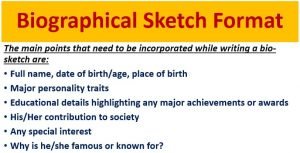
A biographical sketch is always written in the third person and aims at describing the significant achievements or impressive traits of a person’s personality.
Before writing a bio-sketch, the writer needs to conduct a thorough research about the life of the subject he/she has chosen. This can be done by reading reliable information in journals, books, libraries or online database.
The writer can then prepare a timeline of the person’s life and decide which points he/she wishes to highlight. Since a bio-sketch is a brief description, it describes such qualities, events and achievements .
In short, the writer should be able to paint a pen portrait of the subject and convince the reader that the person was unique and worth reading about.
Biographical sketch Solved example
Given examples are of “essay” biographical sketch solved example , you have to write an essay with the help of given clues.
Here we have two solved examples:
- (Biosketch solved example 1) : In the first example “Write a biographical sketch on Vishwanathan Anand not more than 100-120 words”.
- (Biosketch solved example 2) : In the Second example “Write a biographical sketch on Kailash Satyarthi not more than 100-120 words.
Biosketch solved example 1
Write a biographical sketch of Vishwanathan Anand – Grandmaster, a world Chess Champion in your own words in not more than 100-120 words . Clues have been given.
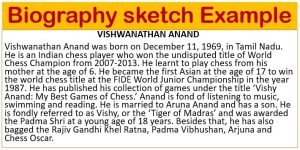
Biosketch solved example 2
Question: Write a biographical sketch of Kailash Satyarthi , a Nobel Peace Prize Honorary, in your own words in not more than 100-120 words , Clues have been given.
Kailash Satyarthi
Born 11 January 1954, Vidisha, Madhya Pradesh, India-academic qualification-Electrical Engineer-family-married, Two children-a daughter and a son-prize motivation – ‘His struggle against the suppression of children and young people and for the right of all children to education’ – awards – Nobel Peace Prize, 2014 (shared with malala Yousafazai) – Defenders of Democracy Award (US), 2009- Alfonso Comin International Award (Spain), 2008 – The Robert. Kennedy Human Rights Award, 1995 – popular child Rights Activist- started a journal ‘The Struggle Shall Continue’ in 1980 (create awareness about child labour) – founder – Bachpan Andolan (BBA), a movement dedicated towards eradication of human trafficking and bonded child labour.
Biographical Solved Example Image
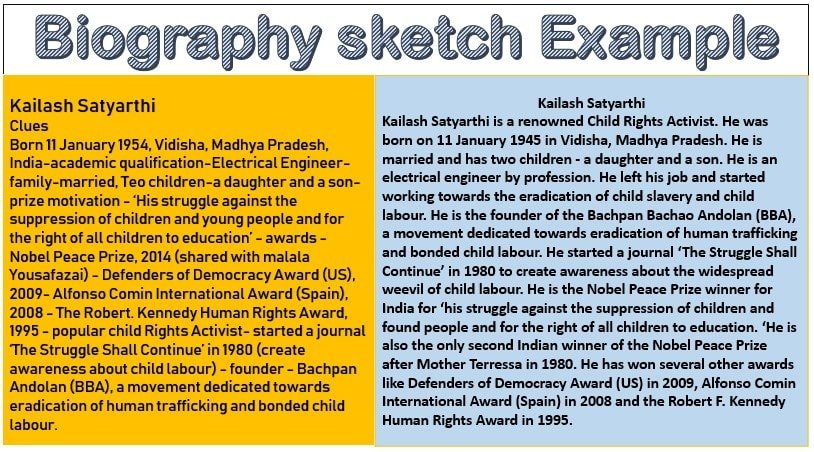
Worksheet for students
Here we have two worksheets read carefully.
- (Worksheet 1): In the first worksheet, you have a paragraph and you have to write a biographical sketch with the help of given hints or Clues in the form of a paragraph .
- (Worksheet 2): In the second worksheet, you have to write a paragraph/biographical sketch with the help of given clues.
Worksheet 1
Write the biographical sketch of Raghuram Rajan, former Governor of RBI, in your own words in not more than 100-120 words. Clues have been given: (biographical sketch example for students)
Former governor-RBI-23rd-born February 3, 1963- Bhopal, Madhya Pradesh – Tamil family – father was senior bureaucrat – graduate from IIT Delhi in 1985- management degree from IIM- Ahmedabad in 1987-doctoral degree in 1991 from MIT-HKUST (Hongkong University of Science and Technology)-vegetarian-loves swimming, squash, tennis, running-married to Radhika Puri-she is a lecturer of law-at Chicago Law School-he served as the Chief Economic Advisor to Finance Ministry- was the youngest Chief Economist- at IMF in 2003 – prestigious awards- Fischer Black Prize-Best Central bank Governor Award-Deutsche Bank Prize for financial economics
Worksheet 2
Write the biography sketch of Nelson Mandela, the first Black President, in your own words in not more than 100-125 words. Clues have been given.
Also, read:
- Notice writing
- Message writing
- Report writing

Biographical Sketch PDF
25 thoughts on “biographical sketch for students, format, solved examples, worksheet”.
Hello, can I get clues for Richard Ebright in biography sketch. Please help…Thank you
thank you abhinav it was absolutely correct we love you
Very nice 👍👍👍 Will use the website again Thank you 😊😊 📝📝
Thank you for your feedback
Write a biographical sketch of sirivennela seetha Rama sastry
Biographical sketch of sirivennela seetha Rama sastry
Sirivennela Seetharama Sastry (a.k.a. Sirivennela), born on May 20, 1955, in Andhra Pradesh, India, is a renowned Indian poet, lyricist, and songwriter. His lyrical prowess and deep understanding of human emotions have made him a prominent figure in the Indian film industry, particularly in Telugu cinema.
Sirivennela’s journey into the world of poetry and lyrics began during his college days, where he developed a passion for literature and music. His talent soon caught the attention of music directors and filmmakers, and he made his debut as a lyricist with the film “Kokila” in 1980. Since then, Sirivennela has penned thousands of songs for Telugu films, showcasing his versatility and creativity.
Known for his profound lyrics and poetic expressions, Sirivennela has collaborated with some of the most celebrated music composers in the industry, including Ilaiyaraaja, A. R. Rahman, and M. M. Keeravani. His songs often delve into themes of love, life, and human relationships, striking a chord with listeners across generations.
Apart from his work in films, Sirivennela has also published several collections of poetry, further establishing himself as a prolific writer. His contributions to the field of literature and music have earned him numerous awards and accolades, including several Nandi Awards and a National Film Award for Best Lyrics.
Sirivennela’s enduring legacy lies in his ability to touch hearts and evoke emotions through his words. His songs continue to be cherished by millions of fans, making him a beloved figure in the world of Telugu cinema and beyond.
Hi this examples where very useful
THE ONE PIECE IS REALLLL!
Thank you for your feedback. Stay tuned for the updates!
This website is very useful for revising the concept before exams. I was able to clear all my doubts by reading the document. I solved the worksheet, to practice my writing skills.
Very good website for help
This website is very helpful for the revision of writing skills before the paper.
You’re welcome!
Hi iam suparna Sengupta your website is very interesting and good for finding examples thanks for your supporting website
Thank you for visiting our website. We appreciate your presence and interest in our platform.
It helped me a lot specially in my exams. I did the worksheets and i saw improvement in me. I got full marks in biographical sketch. Thx for teaching me so well
Your welcome
Hello…This was very helpful…I could not find any question clues for bio sketch on google…This website helped me. Thank you Perform digi! Peace.
Thank you for making this wonderful site. This really helped me to improve my scores.
You’re welcome! I’m thrilled to hear that the site has helped improve your scores. If you have any more questions or need further assistance, feel free to ask. Happy learning!
Leave a Comment Cancel Reply
Your email address will not be published. Required fields are marked *
Save my name, email, and website in this browser for the next time I comment.
Notify me of follow-up comments by email.
Notify me of new posts by email.
Assignment Biography: Student Criteria and Rubric for Writing
Researching an Individual Aligned to Common Core Writing Standards
- Tips & Strategies
- An Introduction to Teaching
- Policies & Discipline
- Community Involvement
- School Administration
- Technology in the Classroom
- Teaching Adult Learners
- Issues In Education
- Teaching Resources
- Becoming A Teacher
- Assessments & Tests
- Elementary Education
- Secondary Education
- Special Education
- Homeschooling
- M.A., English, Western Connecticut State University
- B.S., Education, Southern Connecticut State University
The genre of biography can also be categorized in the sub-genre of narrative nonfiction/historical nonfiction. When a teacher assigns a biography as a writing assignment, the purpose is to have a student utilize multiple research tools to gather and to synthesize information that may be used as evidence in a written report about an individual. The evidence gained from research can include a person’s words, actions, journals, reactions, related books, interviews with friends, relatives, associates, and enemies. The historical context is equally important. Since there are people who have influenced every academic discipline, assigning a biography can be a cross-disciplinary or inter-disciplinary writing assignment.
Middle and high school teachers should allow students to have a choice in selecting the subject for a biography. Providing student choice, particularly for students in grades 7-12, increases their engagement and their motivation especially if students select individuals they care about. Students would find it difficult to write about a person they do not like. Such an attitude compromises the process of researching and writing the biography.
According to by Judith L. Irvin, Julie Meltzer and Melinda S. Dukes in their book Taking Action on Adolescent Literacy:
"As humans, we are motivated to engage when we are interested or have real purpose for doing so. So motivation to engage [students] is the first step on the road to improving literacy habits and skills" (Chapter 1).
Students should find at least three different sources (if possible) to make sure the biography is accurate. A good biography is well-balanced and objective. That means if there is disagreement between sources, the student can use the evidence to state that there is a conflict. Students should know that a good biography is more than a timeline of events in a person's life.
The context of a person's life is important. Students should include information about the historical time period in which a subject lived and did her/his work.
In addition, the student should have a purpose for researching another person's life. For example, the purpose for a student to research and write a biography can be in a response to the prompt:
"How does this writing this biography help me to understand the influence of this person on history, and quite possibly, this person's impact on me?"
The following standards-based criteria and scoring rubrics can be used to grade a student-selected biography. Both criteria and rubrics should be given to students before they begin their work.
Criteria for a Student Biography aligned to Common Core State Standards
A General Outline for Biography Details
- Birthdate /Birthplace
- Death (if applicable).
- Family Members.
- Miscellaneous (religion, titles, etc).
Education/Influences
- Schooling.Training.
- Work Experiences.
- Contemporaries/Relationships.
Accomplishments/ Significance
- Evidence of major accomplishments.
- Evidence of minor accomplishments (if relevant).
- The analysis that supports why the individual was worthy of note in their field of expertise during his or her life.
- Analysis why this individual is worthy of note in their field of expertise today.
Quotes/Publications
- Statements made.
- Works published.
Biography Organization using the CCSS Anchor Writing Standards
- Transitions are effective in assisting the reader to understand shifts.
- Ideas within each paragraph are fully developed.
- Each point is supported by evidence.
- All evidence is relevant.
- Important terms are explained to the reader.
- Purpose of each paragraph (introduction, body paragraphs, conclusion) is clear.
- Clear relationship between topic sentence(s) and paragraph(s) that came before is evident.
Grading Rubric: Holistic Standards with Letter Grade Conversions
(based on extended response Smarter Balanced Assessment writing rubric)
Score: 4 or Letter Grade: A
Student response is a thorough elaboration of the support/evidence on the topic (individual) including the effective use of source material. The response clearly and effectively develops ideas, using precise language:
- Comprehensive evidence (facts and details) from source materials are integrated.
- Relevant, and specific clear citations or attribution to source materials.
- Effective use of a variety of elaborative techniques.
- Vocabulary is clearly appropriate for the audience and purpose.
- Effective, appropriate style enhances content.
Score: 3 Letter Grade: B
Student response is an adequate elaboration of the support/evidence in the biography that includes the use of source materials. The student response adequately develops ideas, employing a mix of precise and more general language:
- Adequate evidence (facts and details) from the source materials is integrated and relevant, yet the evidence and explanation may be general.
- Adequate use of citations or attribution to the source material.
- Adequate use of some elaborative techniques.
- Vocabulary is generally appropriate for the audience and purpose.
- The style is generally appropriate for the audience and purpose.
Score: 2 Letter Grade: C
Student response is uneven with a cursory elaboration of the support/evidence in the biography that includes the uneven or limited use of source material. The student response develops ideas unevenly, using simplistic language:
- Some evidence (facts and details) from the source materials may be weakly integrated, imprecise, repetitive, vague, and/or copied.
- Weak use of citations or attribution to source materials.
- Weak or uneven use of elaborative techniques.
- Development may consist primarily of source summaries.
- Vocabulary use is uneven or somewhat ineffective for the audience and purpose.
- Inconsistent or weak attempt to create the appropriate style.
Score: 1 Letter Grade: D
Student response provides a minimal elaboration of the support/evidence in the biography that includes little or no use of source material. The student response is vague, lacks clarity, or is confusing:
- Evidence (facts and details) from the source material is minimal, irrelevant, absent, incorrectly used.
- Insufficient use of citations or attribution to the source material.
- Minimal, if any, use of elaborative techniques.
- Vocabulary is limited or ineffective for the audience and purpose.
- Little or no evidence of appropriate style.
- Insufficient or plagiarized (copied without credit) text.
- Off-topic.
- Off-purpose.
- Pros and Cons to Flexible Grouping in Middle and High School
- Grading for Proficiency in the World of 4.0 GPAs
- What Is an Annotated Bibliography?
- How to Write an Interesting Biography
- T.E.S.T. Season for Grades 7-12
- Topics for a Lesson Plan Template
- The Whys and How-tos for Group Writing in All Content Areas
- How to Create a Rubric in 6 Steps
- Definition and Examples of Analysis in Composition
- Beef Up Critical Thinking and Writing Skills: Comparison Essays
- What Is Plagiarism?
- 10 Test Question Terms and What They Ask Students to Do
- Higher Level Thinking: Synthesis in Bloom's Taxonomy
- What Is a Rubric?
- Writing Prompt (Composition)
- Rubrics - Quick Guide for all Content Areas
Published In: Brief
How to Write a Biography (Examples & Templates)
A biography is a written account of a person’s life that details their life in chronological order. Another person usually writes this detailed account, and it contains reports of their childhood, career, major life events, relationships, and social impact. It also details their relationships with their family, children, and life accomplishments.
The best way to find out more about a popular figure is through reading their biographies, so you need to make sure you get the correct information. Before writing a biography, you need to do a lot of research and interviews to represent a person’s life accurately.
Types of Biography
A biography is the story of someone’s life as written by another writer. Most biographies of popular figures are written years, or even decades, after their deaths. Authors write biographies of popular figures due to either a lack of information on the subject or personal interest.
A biography aims to share a person’s story or highlight a part of their life.
There are different types of biographies, depending on the story. Some biographies are written true to the story, while some are written as fictional works. Biographies can give you true understanding of a person on an internal as well as external level along with a lot of life lessons.
Autobiography
An autobiography is different from a biography because it is written by the subject of the story, themselves. The author writes in the first-person narrative, and it flows step-by-step like a story of their life. Autobiographies contain personal accounts of the subject’s life, along with their perspectives and opinions on events in their life.
How To Write a Biography
Pick a subject.
Picking a subject is the first step in writing a biography. You can pick an already famous person or a relatively unknown person with a great life story. If you already have a few in mind, you can start by asking yourself some questions such as;
- What has the subject accomplished that makes them a good subject?
- Have they had an impact on society?
- Is the subject a celebrity or a well-known personality?
- Will the biography appeal to a wide audience?
Get Permission
When you pick a subject, the next thing to do is to get permission from them or their family or rights owners. Although, with some historical figures, there may not be any need for permission. Getting permission from your subject makes it easier for you to get stories to put into your book. You can get the chance to obtain additional personal stories and anecdotes that will make your book more interesting by doing so as well.
Do The Research
Research is the most important part of a biography’s process as the entire content of the book is dependent on it. Irrespective of what you know about the subject, you need to carry out as much research as possible to get the story’s facts precisely.
Biography research comes from various sources, depending on the book’s subject. Firsthand reports from family, friends, or personal accounts from the subjects are primary sources. They are usually the most accurate and reliable, and they are crucial for a biography. Secondary sources come from other sources like magazines or documentaries.
Pick a Format
Biographies come in various formats, with each of them having their pros and cons. A typical biography will start at the beginning, usually with the birth and childhood of the subject. Yet, if the biography’s theme involves a different event in their life, the author may want to explore the flashback option or one with concurrent events from different times.
Usually, biographies have a theme or a general life lesson at the center. The author’s role is to tell the subject’s story leading up to the major event.
Which-ever format you choose should place the theme at the center, with the other events detailing the journey.
Create a Timeline Of The Story
Since a biography takes place in chronological order, there needs to be a timeline of the events in the right order. The timeline should contain the key events in the subject’s life, in the order the author plans on revealing them. A great way to declutter the story and keep it interesting is to use flashbacks . This way, the author can introduce past events and explain later events excluding the element of monotony.
Add In Your Thoughts
The good thing about biographies is that you don’t have to stick to the hard facts only. As the author, you can share your opinions and emotions in writing. The author has the freedom to do this by commenting on a significant action by the subject in a manner that describes why they feel the subject may have done what they did.
The author can also include commentary on events depicted in the biography – how it was influenced society or its impact on the lives around them. Recounting these events through a different perspective can make the biography more relatable and interesting to read.
FAQ’s
Why is a biography template important.
A biography template has an outline that makes the writing easier for the author. Biography templates usually contain a sample timeline, format, and questions that provide more information about the subject. With a great biography template, you can cut your writing time in half and spend less time coming up with an outline.
How are biographies better in comparison to autobiographies
Since a different person writes biographies, they tend to be more objective and somewhat accurate than autobiographies. An autobiography tells things from the author’s perspective, so their views and perspective cloud it. Thus, a biography will likely tell a more factual story.
These are the important steps you need to take to help you write a great biography. Now, to make things easier for you, we have a free customizable autobiography and biography template that you can use to start your first book. Get the template and start writing today
What are some of the most important elements to keep in consideration while writing a biography?
Any author looking to write a biography must consider the factors below. They aren’t the only important factors, but a biography isn’t complete without them. • Date and place of their birth • Academic background • Professional expertise • Death, if deceased • Facts and anecdotes about the person • Main accomplishments • Detailed accounts of their child and adult life
Biographies tell the untold stories of some incredibly relevant people in the world. But biographies are not always strictly accurate. So, every biographer needs to follow the necessary steps to provide a biography with all the requirements.
Related Documents

- Book Solutions
- State Boards
Biosketch Class 7 Worksheet
Biosketch Class 7 Worksheet: Hello Students, welcome to Net Explanations. In this page we have posted Biosketch Class 7 English Grammar Worksheet Extra Questions Answers. For more CBSE Board Class 7 Grammar Worksheet you can check this page.
Biosketch Class 7 English Grammar Worksheet
(Total Marks:- 30)
Q.1 Read the notes given below and write a short bio-sketch of Mahatma Gandhi (10 Marks)
Birth Name: Mohandas Gandhi
Place & date of birth: Porbandar, Gujrat, 2nd oct 1869
Parents: Karamchand Gandhi, Putlibai
Education: Studied law UCL faculty of laws (1981)
Work done: he served as a lawyer, politician, activist in the struggle for social justice, salt march, quit india movement
Awards: time person of the year (1930)
Death: 30th January 1948
Q.2 Read the notes given below and write a short bio-sketch of Jyotibrao Phule (10 Marks)
Birth Name: Jyotirao Phule
Place & date of birth: Katugun, 11 April 1827
Parents: father- govindrao phule, mother- Chimanabai phule, wife- savitribai phule
Education: schooling in the year 1847
Work done: Anti-caste , writer, Social reformer, launched first school, education for women, work for dalit samaj
Awards: honorific mahatma in 1888
Death: 28 November 1890
Q.3 Read the notes given below and write a short bio-sketch of Kalpana Chawla (10 Marks)
Birth Name: kalpana
Place & date of birth: karnal, 17th march 1962
Parents: father- Banarasi lal chawla, mother- Sanjyothi chawla
Education:astronaut engineering, masters of science in Aerospace Engineering
Work done: First female to fly on space shuttle
Awards: congressional space medal, NASA Space flight medal, NASA distinguished service medal
Death: 01 February 2003
Answer Sheet
Mondas Karamchand Gandhi, freedom fighter, born on 02nd October 1869 at Porbandar located in Gujrat, India.
His father’s name is Karamchand Gandhi and Mother’s name Putlibai Gandhi. Talking about Mahatma Gandhi’s education, he studied arts and law. UCL faculty law from London in the year 1891.Gandhiji served as a lawyer, politician and social former. He put the action of satyagraha. He is non-violent resistance to British rule, he was also influenced by religious concepts. Mahatma Gandhi launched the salt March as a protest against a British tax on salt. The march was a successful campaign of gandhi.
He was also involved in the Quit India Movement. Mahatma Gandhi was awarded time person of the year in the year 1948. He was nominated several times for the Nobel peace prize but was never awarded the prize. He died on 30th january 1948.
Answer :- Jyotirao Phule was born on 11 April 1827 at Katugun, Satara, Maharashtra. He belongs to other backward class from the Mali samaj. His father’s name was Govindrao Phule, mother’s name ChimanabaiPhule and his wife name Savitribai Phule. Jyotirao Phule completed his school in the year 1847. He was social reformer anit8 caste, writer, worked for schedule caste. He is known by everyone because he is the person who launched first school and provided education to women.
As in early days females did not had rights of education, Jyotirao Phule was totally against it. He taught his wife at home and later they both started teaching females at free of cost. His wife faced many difficulties, people threw cowdung on her face while she use to go for teaching as she supported the women education. Jyotirao Phule always stood by his wife and supported her. Jyotirao Phule is also known as Mahatma Jyotiba Phule. He was been awarded honorific mahatma in 1888. JyotibaPhule died on 28 th November 1890 as he was suffering from a paralytic stroke which worsened his health conditions .
Kalpana Chawla was born on 17 th March 1962 at Karnal.Haryana. Her father was Banarasilal Chawla and mother was SanjyothiChawla. Kalpana was youngest of 4 children. She completed Aeronautical Engineering from Punjab Engineering College, India. Later she completed Masters of Science degree in Aerospace Engineering. Kalpana Chawla was first Indian born female to fly in the space. She became a inspiring woman for millions of females in India by becoming first woman to become astronaut engineer. Kalpana Chawla was awarded with Congressional space, NASA Space flight medal, NASA distinguished service medal. She was assigned many special missions. The Space shuttle Columbia disaster, where Kalpana Chawla died with her crew members on 1 st February 2003.
Also see: Letter writing worksheet 7th standard
Ending of the bio sketch should be different like : This great man , Mahatma Gandhi left this world on 30th January
If you wish you can write
Leave a Reply Cancel reply
Your email address will not be published. Required fields are marked *
Save my name, email, and website in this browser for the next time I comment.
We have a strong team of experienced Teachers who are here to solve all your exam preparation doubts
Sikkim scert class 5 english chapter 4a picture reading solution, west bengal board class 9 english solution chapter 2 all about a dog, aees class 7 hindi question paper, multiplication class 3 worksheet.
Sign in to your account
Username or Email Address
Remember Me
Biosketch And Biographical Sketch Example For Students Of Class 7 And 8
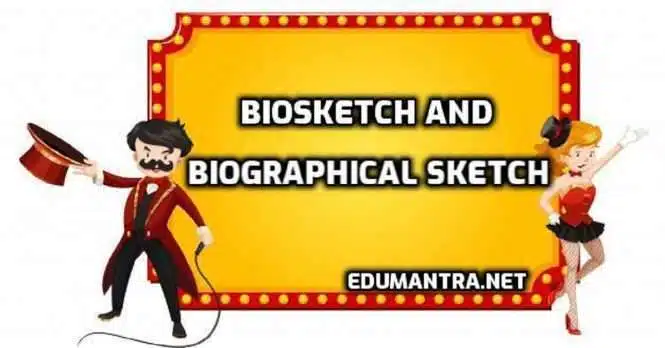
1.If one has good neighbours life becomes good and livable. If one has bad or quarrelsome neighbours, life becomes a hell. Imagine you have a quarrelsome neighbour. Write a description of him in 100 words.
A Troublesome Neighbour
My Quarrelsome Neighbour

One is lucky if one has a good neighbour. Good neighbours make life livable. They stand by one’s side in times of joy and sorrow. They are thus very near one’s heart in bad times. Relatives come later. But neighbours are with one every time. But if one has a quarrelsome neighbour one’s life is spoiled. A troublesome neighbour makes life around him a hell. Mr V.K. Sharma is such a neighbour. He has many bad habits. He seems to be abnormal. He shouts at his wife and children. He has no love for his wife and children. He drinks daily. He quarrels with everyone in his neighbourhood. His neighbours avoid him. He doesn’t cooperate with anyone. If one goes to him for some act of charity, he insults him. He is anti-social and anti-human. It is a curse to have such a neighbour.
Download the above Description in PDF
2. If one has a real grandmother who has all the good human qualities life becomes bliss. Imagine you have such a grandmother who is still active despite her age. Write a paragraph in about 100 words on your grandmother.
Answer
My Grandmother
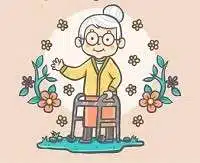
Like all grandmothers, my grandmother is also old. She has wrinkles all over her body. She is seventy years old. Despite it, she is still very active. She has no lethargy or laziness. She gets up early in the morning. She takes a bath and prays before the household goddess. She also reads Holy Scriptures and recites them when she has time in the day. She helps my mother in the kitchen. She does shopping also. She takes me to the bus stand. She also helps me in my studies as she has a vast knowledge of all things. She feeds the sparrows during the afternoon as it is her favourite hobby. I love her very much.
3. Description of our Prime Minister
- Name: Mr. Narender Modi
- Qualities of a true leader : Honest, hard-working. humble
- Different from another leader: No desire of name, fame
- Mission: Service to the nation
- The expectation from him: To take the country to greater heights
Ans. Our Prime Minister Mr. Narender Modi
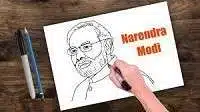
Mr. Narender Modi is my favourite leader. He is the Prime Minister of India. He has all the true qualities of a true leader. He is honest and a hardworking lie is very humble. His simplicity connotes him. There is no trace of any pride in him. He is very different from other political leaders. the lie has no desire for any name, fame, or riches. He is a faultless and blotless Personality. Service to the nation is the only mission of his life. All the Indians hold hint in high esteem and expect that he will take the country to greater heights.
4. Last year your school appointed a new T.C.T. who came to teach you English in class 9. You are very impressed with her. Write a description of your T.G.T. (English) in about 100 words. You may use the clues given below.
- qualifications, college/university’
- personality
- attitude toward students
- manner of teaching
- problem-solving
- course punctuality
- weak students
Ans. My Favourite Teacher

Our English teacher Mrs. Rita Raman is one of the best teachers that I have ever come across. She graduated from Hindu caw and then secured her B.Ed. degree from the University of Delhi. She is very friendly and charming. Her dresses are extremely interesting Instead of giving a monotonous lecture; she allows the students to and shares their views. The students are never afraid to approach her. The best thing about Mrs. Rita Raman is her punctuality. She never fails to complete the syllabus on time. Mrs. Raman gives special attention to the weaker students and motivates them to work hard. She is indeed a wonderful person.
5. Given below is the profile of a school teacher. Write a short paragraph about NIS Deepti Sharma describing her in 80 to 100 words.
Age: Around 45 years
Height weight : medium built, dominating yet attractive
Family : Unmarried. One sister, one brother
Education : M. Sc. Chemistry – her hobbies likes/dislikes, the way of dressing, talking command over the language
Why she is popular/unpopular : Her role as a teacher in shaping the future of the students
Ans . Mrs Deepti Sharma
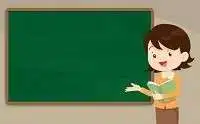
Ms. Deepti Sharma is my favourite teacher. She is medium built neither tall nor short and would be around 45 years old. She may not be very beautiful but she is dominating yet attractive. She has preferred to stay single and has a brother and a sister. She has done an M.Sc. in Chemistry and her hobby is to listen to instrumental music whenever she is free. She likes to keep the company of simple people and she hates perfumes. She is always gracefully dressed. She is very soft-spoken and has a good command over languages. It is because of all these attributes that she is very popular among the students. Her personal concern for every student makes her everyone’s favourite she has contributed a lot in shaping the future of the students.
Downl oad t h e above Description in PDF
6. With the help of the given clues, write a bio-sketch of Subhash Chandra Bose in not 80-100 words.
Name: Subash Chandra Bose; Netaji
Contribution: immense, Freedom Fighter
Born: January 23, 1897, in Cuttack, Orissa
Career: Civil Services
Achievements: Joined struggle; established Indian National Army
Motto Give me blood and I will give you the freedom
Setback: Retreat after the defeat of Japan and Germany
Death Air crash over Taipei, Taiwan (Formosa) on August 18, 1945
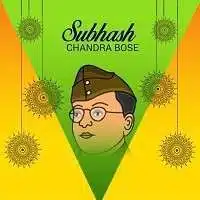
Ans. Subhash Chandra Bose, affectionately called Netaji, was born on January 23, 1897, in Cuttack, Orissa. He was one of the most prominent leaders of the Indian freedom struggle. Deeply moved by the Jallianwala Bagh massacre, he gave up a promising career in the Civil Service to join the Freedom Movement. He founded the Indian National Army to overthrow the British Empire from India. His famous motto was “Give me blood and I will give you freedom”. However, the defeat of Japan and Germany in the Second World War forced INA to retreat and it could not achieve its objective. Subhash Chandra Bose was reportedly killed in an air crash over Taipei, Taiwan (Formosa) on August 18, 1945.
Download the above Bio-Sketch in PDF
7. Use the information given below and complete the biography in about 80 to 100 words. P. T. Usha
1964 : Born on May 20th at Keothali in Kerala
1973: Discovered by a dedicated physical education teacher
1975: Badly injured while practicing for sub-junior district level athletics. Participated in 100 meters, 200 meters, long jump, high jump-first in all four events
1982: Two silver medals in New Delhi Asian Games
1984: Fourth place in 400 in at Los Angeles Olympics
1985: Best female Athlete in Jakarta Asian Meet
1986: Four gold and one silver medal at Seoul Asian games
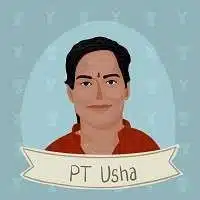
Ans. P. T. Usha was born in Keothali, Kerala on 20th May 1964. In 1973 she was discovered by a dedicated physical education teacher. In 1975, she was badly injured while practicing for Sub-junior district athletics. She participated in 100m, 200m, long jump, and high jump. She bagged the first position in all four events. In 1982, she got two silver medals in New Delhi Asian Games. In 1984, she came fourth in 400 m at the Los Angles Olympics. In 1985, she won the award for the best female athlete in Jakarta Asian Meet. In 1986, she was awarded four gold and one silver medal at the Seoul Asian Games.
8. Given below is a profile of Kiran Bedi, the super cop of India. Write a short bio—sketch of Kiran Bedi taking the help of the clues given below
Aged: Around 65 years, robust physique. Pleasing and dynamic personality
Family: Second of four daughters, born into an extraordinary family with visionary parents
Education: Bachelors Degree in English from Amritsar (1968). Masters in Political Science. LLB from Delhi University and a Ph.D. degree from IIT Delhi (1993)
Hobbies: Great tennis player, noted author, social worker
Profession: The first woman officer in the elite Indian Police Service (1972),: The Inspector General of Asia’s biggest Jail — the Tihar Jail in 1993. Introduced many classes and programmes for the inmates including those on basic education, meditation, yoga besides functions like Kavi Sammelans, dramas, and games
Why distinct from Has won President’s Gallantry Award (1979), Asia Region Award for others
Recognition: Drug Prevention and Control (1991), Ramon Magsaysay Award (1994), Bharat Gaurav Award (1999), and many other prestigious awards. The first Indian to be appointed to the prestigious post of United Nations Civilian Police Adviser. Set up India Vision Foundation to work in the field of Prison reforms crime prevention, rural development sports promotion, etc
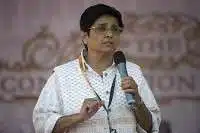
Ans. Dr. Kiran Bedi is a powerful cop, with a robust physique, pleasing, and dynamic personality. Born into an extraordinary family with visionary parents 65-year-old Kiran Bedi is the second of four daughters. She has got a Masters in Political Science, LLB from Delhi University, and a Ph.D. degree from IIT Delhi. She was also a great tennis player. She is also a noted author. Kiran Bedi became the first woman officer in the elite Indian Police Service and the most memorable moment of her career came when she served as the Inspector General of Asia’s biggest-Jail -the Tihar Jail in 1993. She introduced many classes and programmes for the inmates of the Jail on the basis of education, meditation, Yoga, dramas, and games. Kiran Bedi has won many awards – the Presidents Gallantry Award (1979). Asia Region Award for Drug Prevention and Control (1991), Ramon Magsaysay Award (1994), Bharat Gaurav Award (1999) and she was the first Indian to be appointed to the prestigious post of United Nations Civilian Police Advisor. Kiran Bedi has also been very active in community service and she set up India Vision Foundation.
Related Posts
Login Or Join Extramarks
Login with social media
Mathematics
Social science, punctuation, subject-verb agreement, the sentence, interjections, conjunctions, prepositions, parts of speech, auxiliaries, determiners, letter - formal, letter - informal, paragraph writing, picture composition, report writing, diary entry, data interpretation, process description, story writing, description of persons, places and events, article writing, dialogue writing, (honeycomb) - prose -1. three questions, (honeycomb) - poem -1. the squirrel, (honeycomb) - prose -2. a gift of chappals, (honeycomb) - poem -2. the rebel, (honeycomb) - prose -3. gopal and the hilsa fish, (honeycomb) - poem -3. the shed, (honeycomb) - prose -4. the ashes that made trees bloom, (honeycomb) - poem -4. chivvy, (honeycomb) - prose -5. quality, (honeycomb) - poem -5. trees, (honeycomb) - prose -6. expert detectives, (honeycomb) - poem -6. mystery of the talking fan, (honeycomb) - prose -7. the invention of vita-wonk, (honeycomb) - poem -7. dad and the cat and the tree, (honeycomb) - prose -8. fire: friend and foe, (honeycomb) - poem -8. meadow surprises, (honeycomb) - prose -9. a bicycle in good repair, (honeycomb) - poem -9. garden snake, (honeycomb) - prose -10. the story of cricket, words denoting collection, words expressing cries of animals and birds, diminutives, occupations, friendly communications, homes and places, things where kept, things where made, games where played, countries, their adjectives and persons, names of young ones, single word for group of words, comparisons, word formation-primary derivatives, active and passive voice, direct and indirect speech, pieces of things, sounds made by various objects, figures of speech, phrasal verbs, rhyming words, compound words, non-finites, question tags & short answers, sentence structure, synthesis of sentences, transformation of sentences, condition, concession and contrast, the sequence of tenses, reading for comprehension, finding the root word and parts of speech, (supplementary reader) - 1. thetiny teacher, (supplementary reader) - 2. bringing up kari, (supplementary reader) - 3. the desert, (supplementary reader) - 4. the cop and the anthem, (supplementary reader) - 5. golu grows a nose, (supplementary reader) - 6. i want something in a cage, (supplementary reader) - 7. chandni, (supplementary reader) - 8. the bear story, (supplementary reader) - 9. a tiger in the house, (supplementary reader) - 10. an alien hand, jumbled words, computer science, हिन्दी व्याकरण - ब, there is no content available.
To Access the full content, Please Login /--> Purchase
Extramarks Smart Study Pack

Annual Pack

- Google Plus
Copyright © 2018 Extramarks. All rights reserved.
Forgot Password?
Please enter your User ID:
Having trouble logging in? call at 18001025301
Please remember changing your password here will change the same for www.findingkalam.com as well as www.extramarks.com
Login with your Google account
Change registered mobile.
Enter your email to change registered mobile number:
Update your Photo
(max file size 1mb)
Select Board Class
Select subjects, we offer various courses corresponding to your board & class.select your course from here..
Class 7 English Grammar Chapter 1 The Sentence
Class 7 English Grammar Chapter 1 The Sentence. Here, we will learn about the different kind of sentences with example and explanation. When we speak or write something, we use words. The words used in speech are called spoken words. The words used in writing are called written words. Words are made up of letters. Words spoken or written in a group express what we want to say to another person. A word-group may be small or big. “A word is a group of letters that has some meaning.”
Class 7 English Grammar Solutions Chapter 1 The Sentence
- Class 7 English Grammar: The Sentence.
- Class 7 English Grammar Chapter 1 Revision Book
- Class 7 English Grammar Next Chapter
- Class 7 English Grammar Main Page
- Class 7 English NCERT solutions
- Class 7 all Subjects Solutions
In Chapter 1 of Class 7 English Grammar, we delve into the foundational concept of sentences. A sentence is more than just a random assortment of words; it’s a structured combination that conveys a clear message or idea. Whether spoken aloud or jotted down, sentences are the building blocks of communication. These sentences, based on their construction and intent, can be categorized into different types, each serving a distinct purpose. By mastering the art of sentence formation, one can effectively express thoughts, emotions, and information.
According to Wren and Martin a group of words, which makes sense but not complete sense, is called a phrase, They are groups of words which make sense, but their sense is not complete. They do not express a whole idea; as, in the park, in front of, on the table, under a shady tree etc.
The foundation of any sentence lies in the words it comprises. Words, which are sequences of letters, carry meaning and are the essence of language. There are two primary mediums for words: spoken and written. Spoken words, as the name suggests, are vocalized, while written words find their way onto paper or digital screens. Regardless of the medium, the power of words is undeniable. As we navigate through language learning, it’s essential to remember, “A word is a group of letters that has some meaning.” This understanding is pivotal in mastering the intricacies of English Grammar.
When groups of words make complete sense. They are sentences. According to Wren and Martin a group of words which makes complete sense is called a Sentence.
- The girls are playing.
- Amit is standing in front of the house.
- Cows are sitting under a shady tree.
- The children are playing in the park.
- The books are on the table.
Simple Sentence
A simple sentence is made up of one complete subject and one complete predicate. Declarative or Assertive Sentences, Questions or Interrogative Sentences, Imperative Sentence or Commands Exclamatory Sentences, Optative Sentences.
Interrogative Sentence
An Interrogative Sentence is a simple sentence that asks a question about something. Each of these is a simple sentence. It asks a question or interrogates about something. So, such sentences are called questions or interrogative sentences.
- Do you smoke?
- Are you ill?
- What is your name?
- Where do you live?
- It is very hot today, isn’t it?
- It is not very hot today, is it?
Change of Assertive Sentence into Interrogative Sentence
We can change an assertive sentence into interrogative by placing the special verb in the beginning of the sentence.
Forming Questions
They begin with question words (what, when, why, where, who, whom, whose, which, how, how many, how much, how old, how far etc.)
- When do you go to school?
- Whom do you want?
- Which doll does she like?
- How do you climb a tree?
- How old are you?
- Whose book is this?
- How far is your village?
- How much money have you?
Question Tags or Tail Questions
It is a common practice in conversation to make a statement and to ask the listener to confirm it. Helping verbs are used to make question tags. The subject of the Question Tag is always a Pronoun. A positive statement takes a negative tag and a negative statement a positive tag.
- I am busy, aren’t you?
- I am not busy, am I?
- The earth is round, isn’t it?
- You are a fool, aren’t you?
- You live at Shrinagar, don’t you?
- You don’t like it, do you?
- He can speak English, can’t he?
- You won’t forget, will you?
- Let us leave now, shall we?
- She isn’t going alone, is she?
Exclamatory Sentences
Exclamatory Sentences are those which express strong or sudden feelings or emotions of joy, wonder, anger, sorrow, contempt etc. Such a sentence usually begins with how or what and ends in an Interjection.
- How wise Pushpender is! (wonder)
- What a lovely doll (it is)! (surprise)
- What charming looks! (surprise)
- Hurrah! I have passed. (joy)
- Fie! How dirty a room. (contempt)
- Alas! I am undone. (sorrow)
- Alas! I have failed. (sorrow)
- Shut up! You wretch. (anger)
- Bravo! You have won the war. (praise)
- Hello! How goes the world? (greeting)
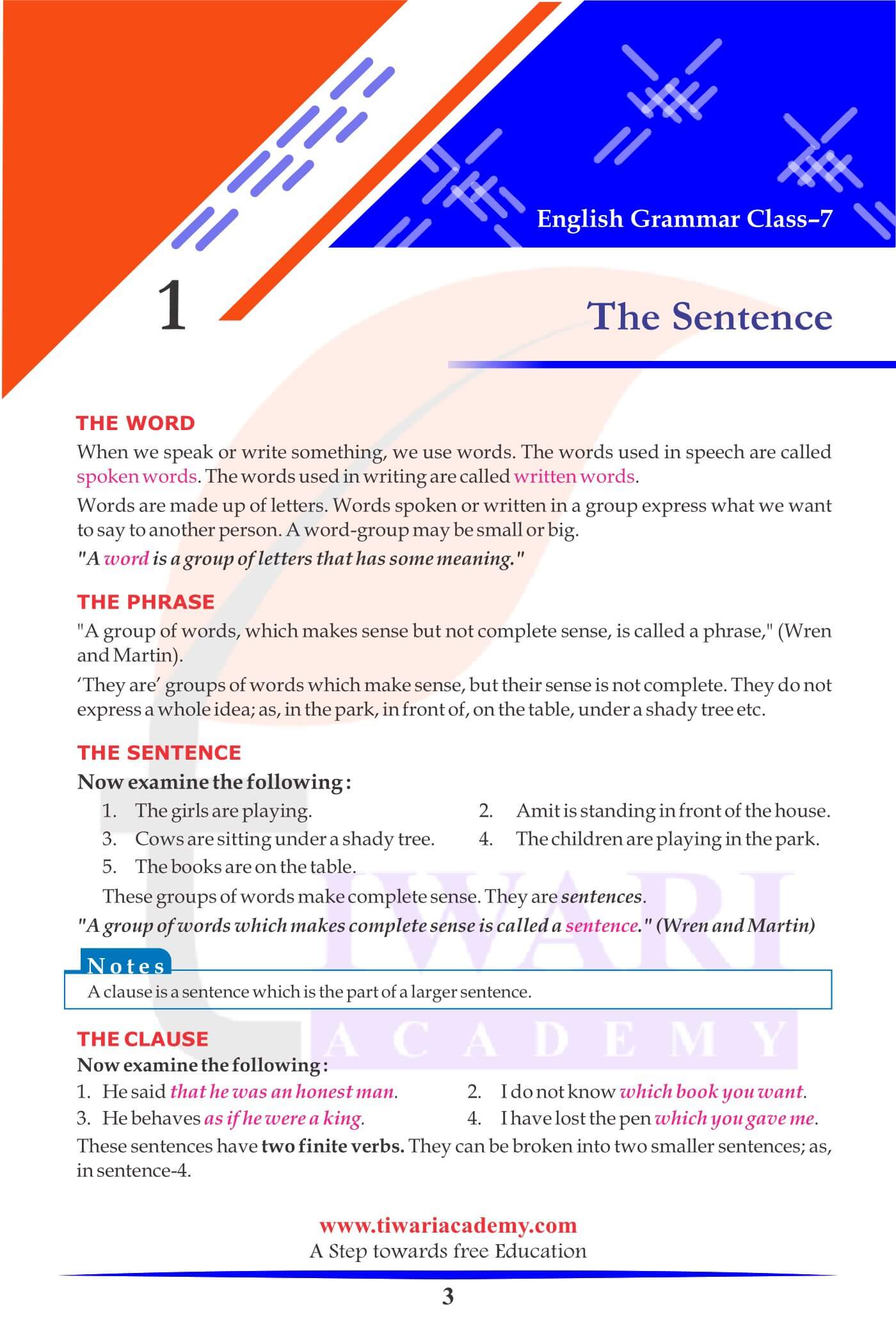
Copyright 2024 by Tiwari Academy | A step towards Free Education


IMAGES
VIDEO
COMMENTS
To improve bio sketch writing skills, students can practice with the following exercises: Exercise 1. Choose a famous historical figure and write a bio sketch that highlights their major achievements, contributions, and impact on society. Exercise 2. Imagine yourself as a sports personality or a successful entrepreneur.
These sentence starters and connectives will ensure that you get biographies from your students that are interesting and differ from each others. Print them out as is and give one to each of your students for their books or enlarge them to use as posters around your room. * The time came for…. * Soon afterwards…. * Shortly after this….
BIOGRAPHY WRITING Tip: #4 Put Something of Yourself into the Writing. While the defining feature of a biography is that it gives an account of a person's life, students must understand that this is not all a biography does. Relating the facts and details of a subject's life is not enough.
Biosketch solved example 2. Question: Write a biographical sketch of Kailash Satyarthi, a Nobel Peace Prize Honorary, in your own words in not more than 100-120 words, Clues have been given. Kailash Satyarthi. Clues. Born 11 January 1954, Vidisha, Madhya Pradesh, India-academic qualification-Electrical Engineer-family-married, Two children-a daughter and a son-prize motivation - 'His ...
Students should know that a good biography is more than a timeline of events in a person's life. The context of a person's life is important. Students should include information about the historical time period in which a subject lived and did her/his work. In addition, the student should have a purpose for researching another person's life.
A biography is the story of someone's life as written by another writer. Most biographies of popular figures are written years, or even decades, after their deaths. Authors write biographies of popular figures due to either a lack of information on the subject or personal interest. A biography aims to share a person's story or highlight a ...
Biosketch Class 7 English Grammar Worksheet. (Total Marks:- 30) Q.1 Read the notes given below and write a short bio-sketch of Mahatma Gandhi (10 Marks) Birth Name: Mohandas Gandhi. Place & date of birth: Porbandar, Gujrat, 2nd oct 1869. Parents: Karamchand Gandhi, Putlibai.
If you're interested in writing a biography, the following steps can get you started: 1. Get permission. Once you've chosen the subject of the biography, seek permission to write about their life. While in some cases it may not be necessary (like if the subject is a public figure or deceased), getting permission will make the research ...
Writing the Biography. A paragraph will often begin with a topic sentence that signals the main idea to your readers. You don't have to begin with a topic sentence, but you'll need to make sure ...
3. Failing to capitalize "biography" when referring to a specific work: When mentioning the title of a specific biography, it is important to capitalize the word "biography" as you would with any other title. Incorrect Example: "I recently read a biography of Leonardo da Vinci.".
That makes this activity the perfect opportunity for your students to become self-sufficient writers. With these writing prompts, students will get a helpful little boost to help them describe their biography subject. Students will simply choose a prompt and use their research to complete the first sentence…. And, ideally, the next one.
Biography Characteristics. Since biographies are real-life stories, they are considered a genre of non-fiction books. Genres are categories or types of books that have similar characteristics. Non ...
Download the above Bio-Sketch in PDF. 7. Use the information given below and complete the biography in about 80 to 100 words. P. T. Usha . 1964: Born on May 20th at Keothali in Kerala. 1973: Discovered by a dedicated physical education teacher. 1975: Badly injured while practicing for sub-junior district level athletics. Participated in 100 ...
Donald Trump. This biography details the 45th President of the United States' life, including his father's success in real estate, his three marriages, and his journey to becoming president. This biography can be used for your social studies lessons or simply to educate your children about the current president.
This Biography Writing Examples set contains resources such as an annotated example text, which explores the decisions the writer has made and why they're effective, and a useful biography word mat to help students to learn some of the key terms that crop up in this style of writing. This would be a great choice of resource if students are just ...
This pack shows you an example of a biography that a child aged 7 - 9 might be expected to write. There is a handy checklist of features, each highlighted in an example text and explained just for you. ... Second Grade . 7 - 8 years old . Third Grade . 8 - 9 years old ... Biography Sentence Starters. Information Texts: Biography Model/Example Text.
Support your Year 3-6 students to write a biography! Provide your students with a little bit of inspiration and guidance when writing a biography with these biography themed sentence starters and suggested phrases to get them started. These sentence starters and connectives will help scaffold the writing of biographies from your students that ...
If you're wondering what is expected of your child in their writing, why not take a look at our Example Text Packs for Parents? This pack shows you an example of a biography that a child aged 7 - 9 might be expected to write. There is a handy checklist of features, each highlighted in an example text and explained just for you. Use this pack to help you understand what your child's teacher ...
With increasingly challenging ranges of grammar, punctuation and spelling expectations, this pack illustrates how a year group's word, sentence and whole text level writing aims can be incorporated into one complete piece of writing. Tags in this resource: Use this example text pack to help you provide an ideal example Biography text for year ...
Sentence Structure. Synthesis of Sentences. Transformation of Sentences. Condition, Concession and Contrast. The Sequence of Tenses. Reading for Comprehension. Finding the Root Word and Parts of Speech. Prefixes (Supplementary Reader) - 1. TheTiny Teacher (Supplementary Reader) - 2. Bringing up Kari (Supplementary Reader) - 3. The Desert ...
In Chapter 1 of Class 7 English Grammar, we delve into the foundational concept of sentences. A sentence is more than just a random assortment of words; it's a structured combination that conveys a clear message or idea. Whether spoken aloud or jotted down, sentences are the building blocks of communication.
Give students a jumpstart on writing about people with 24 sentence starters. ... Biography Writing for 3rd Grade Biography Writing for 5th Grade Biography Writing for 6th Grade Biography Writing for 7th Grade About Us. About Us; One Million Trees Project; Testimonials & Reviews Careers; More. Plans & Pricing Curriculums Teach Starter Australia
Definition of Sentence. A group of words that is arranged in a proper order and gives a complete meaning is called a sentence. e.g. Delhi is the capital of India. Manohar is the captain of team. Subject. A subject is a noun or pronoun that either does the work or about whom/which something is stated. e.g.